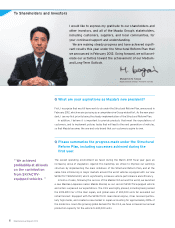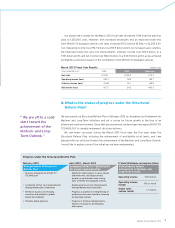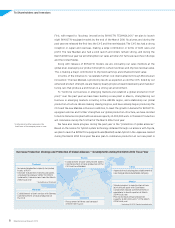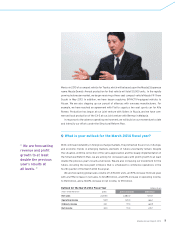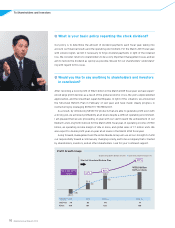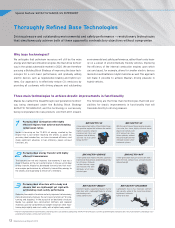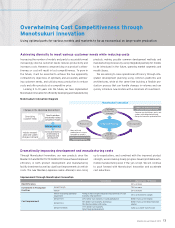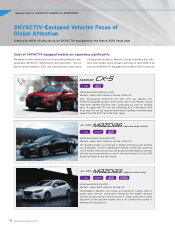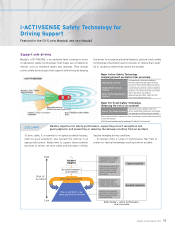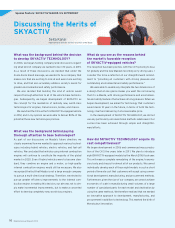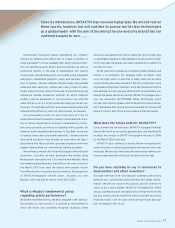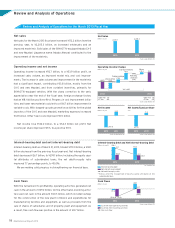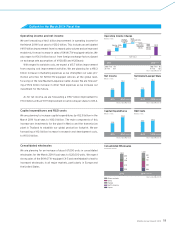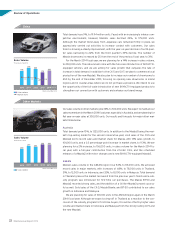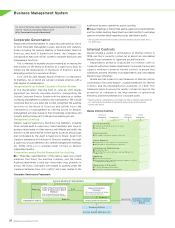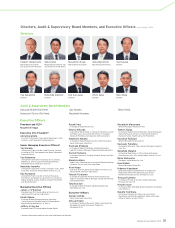Mazda 2013 Annual Report Download - page 18
Download and view the complete annual report
Please find page 18 of the 2013 Mazda annual report below. You can navigate through the pages in the report by either clicking on the pages listed below, or by using the keyword search tool below to find specific information within the annual report.
Discussing the Merits of
SKYACTIV
What was the background behind the decision
to develop SKYACTIV TECHNOLOGY?
In 2006, we began holding company-wide discussions regard-
ing what kind of company we wanted to be in 10 years, in 2015.
As a result of these discussions, we decided that under the
Zoom-Zoom brand message, we wanted to be a company that
makes cars that are exciting to look at and even more exciting
to drive, and that also accurately address society’s needs for
greater environmental and safety performance.
We also decided that building this kind of vehicle would
require thorough attention to all of the vehicle base technolo-
gies. Subsequently, we began development of SKYACTIV as
the concept for the realization of radically new, world-class
technologies for engines, transmissions, bodies, and chassis.
We launched the CX-5 as the first SKYACTIV-equipped vehicle
in 2012, and in my opinion we were able to deliver 80% of the
potential these new technologies promise.
What was the background behind paying
thorough attention to base technologies?
As part of our discussions on Mazda’s future direction, we
closely examined how we wanted to approach various technol-
ogies including hybrid vehicles, electric vehicles, and fuel-cell
vehicles. We concluded that vehicles using internal combustion
engines will continue to constitute the majority of the global
market in 2020. Even if hybrid vehicles were to become stan-
dard, they combine an engine and a motor, so high-quality
internal combustion engines would still be necessary. We also
recognized the fact that Mazda is not a large enough company
to pursue a multi-directional strategy. Therefore, we elected to
pursue greater efficiency improvements to the internal com-
bustion engine. In making this decision, our aim was not to sim-
ply make incremental improvements, but to make a concerted
effort to develop completely new, world-class engines.
What do you see as the reasons behind
the market’s favorable reception
of SKYACTIV-equipped vehicles?
The reception has been positive, with the CX-5 proving to be a
hit globally and the new Mazda6 recording very strong sales. I
consider this to be a reflection of our straightforward commit-
ment to “providing all customers with driving pleasure and
outstanding environmental and safety performance.”
We were able to seamlessly integrate the two dimensions of
a design that at one glance makes you want the car knowing
that it is a Mazda, with driving performance and environmen-
tal and safety features that achieve driving pleasure. When we
began development, we aimed for technology that customers
would desire 10 years in the future, in terms of both the tech-
nology itself and delivering it at a reasonable price.
In the development of SKYACTIV TECHNOLOGY, we did not
use any particularly unconventional methods whatsoever. Our
success has been achieved through simple and straightfor-
ward efforts.
How did SKYACTIV TECHNOLOGY acquire its
cost competitiveness?
We began development in 2006 and commenced mass produc-
tion of the CX-5 five years later in 201 1. We plan to introduce
eight SKYACTIV-equipped models by the March 2016 fiscal year.
This will mean a complete remodeling of the engine, transmis-
sion, body, and chassis for almost all of our products. We cannot
individually develop each of those eight models in such a short
period of time at a cost that customers will accept using conven-
tional development, manufacturing, and procurement methods.
Furthermore, given the size of our company, we cannot achieve
economies of scale in manufacturing small volumes of a large
number of specialized parts for each model and destination by
using the same methods. We therefore realized that we needed
an innovative approach to development, manufacturing, and
procurement in addition to technology. This marked the birth of
Monotsukuri Innovation.
Special Feature: SKYACTIV MAKES US DIFFERENT
Seita Kanai
Representative Director and Vice Chairman of the Board
Mazda Annual Report 2013
16


